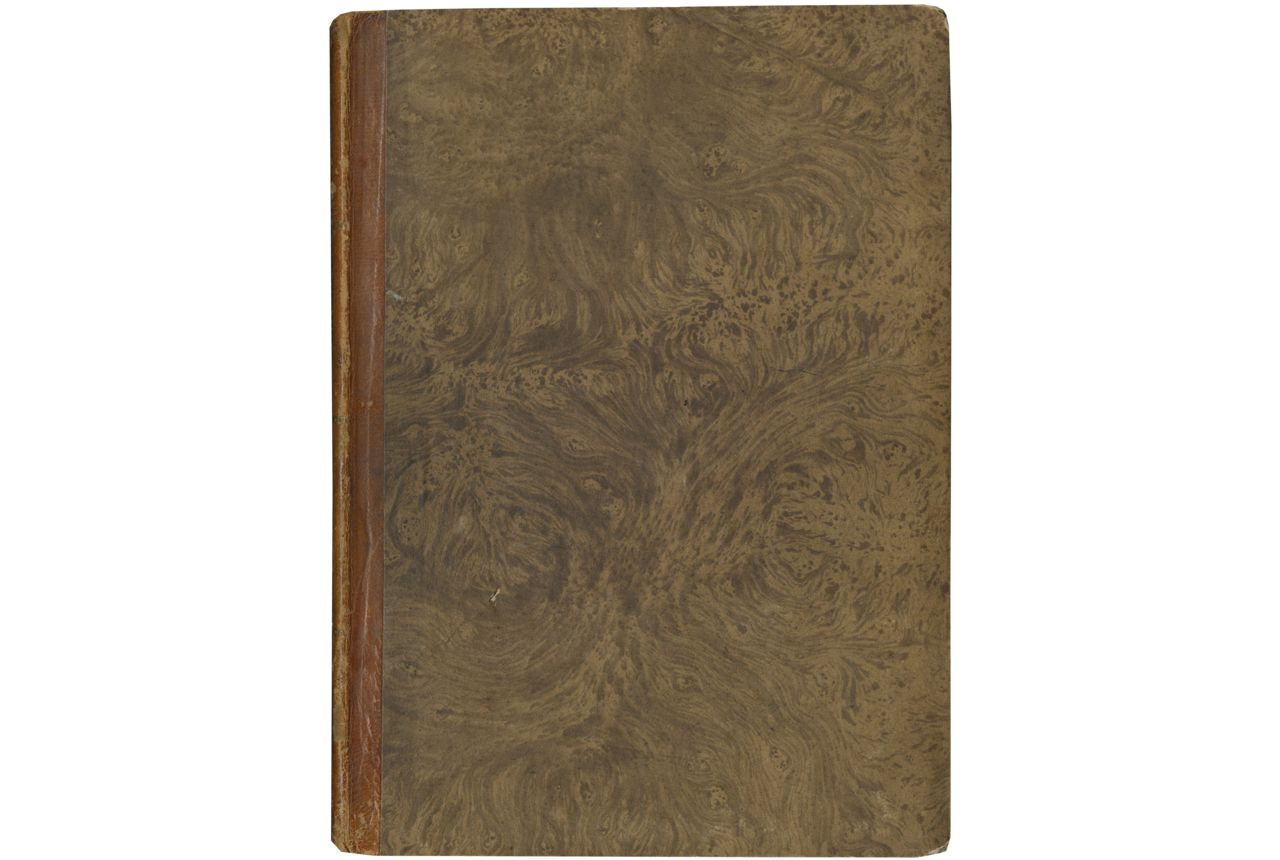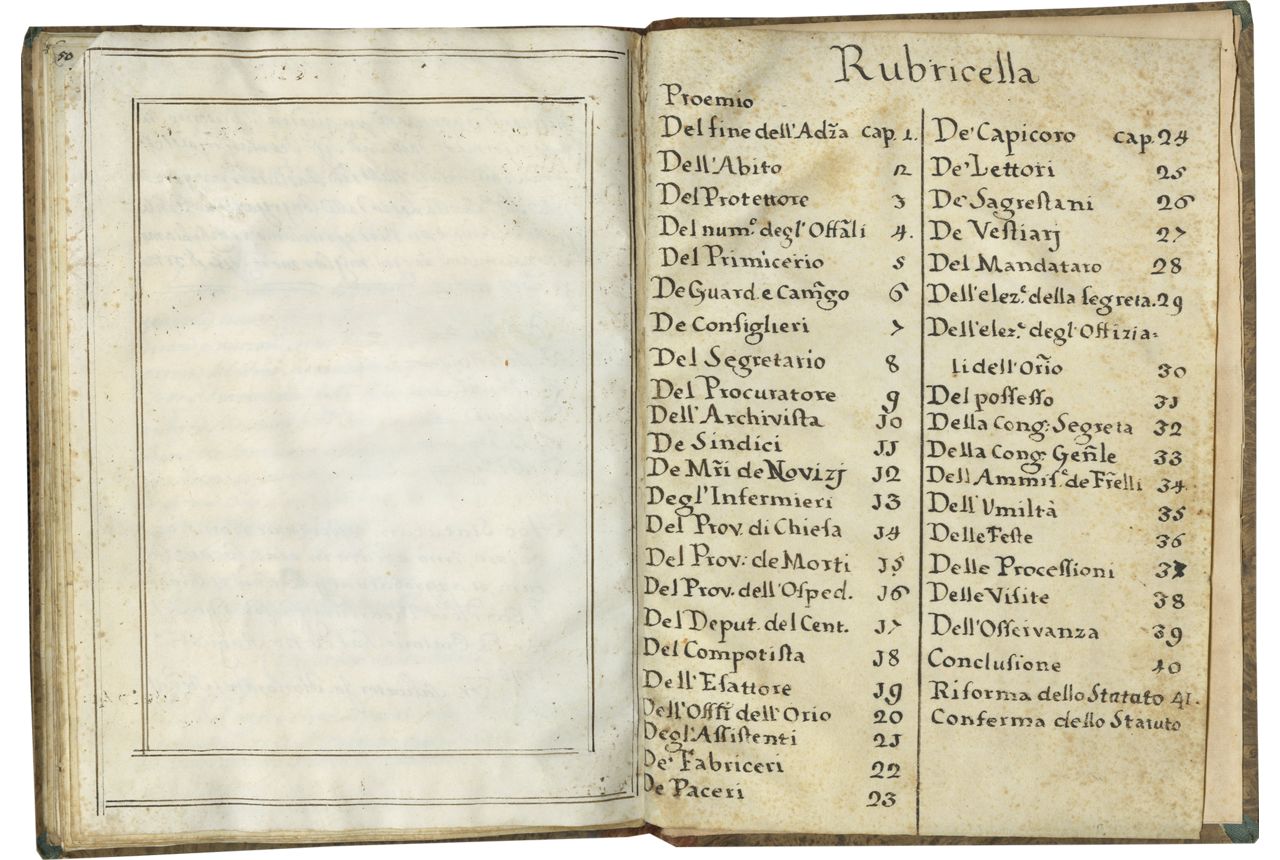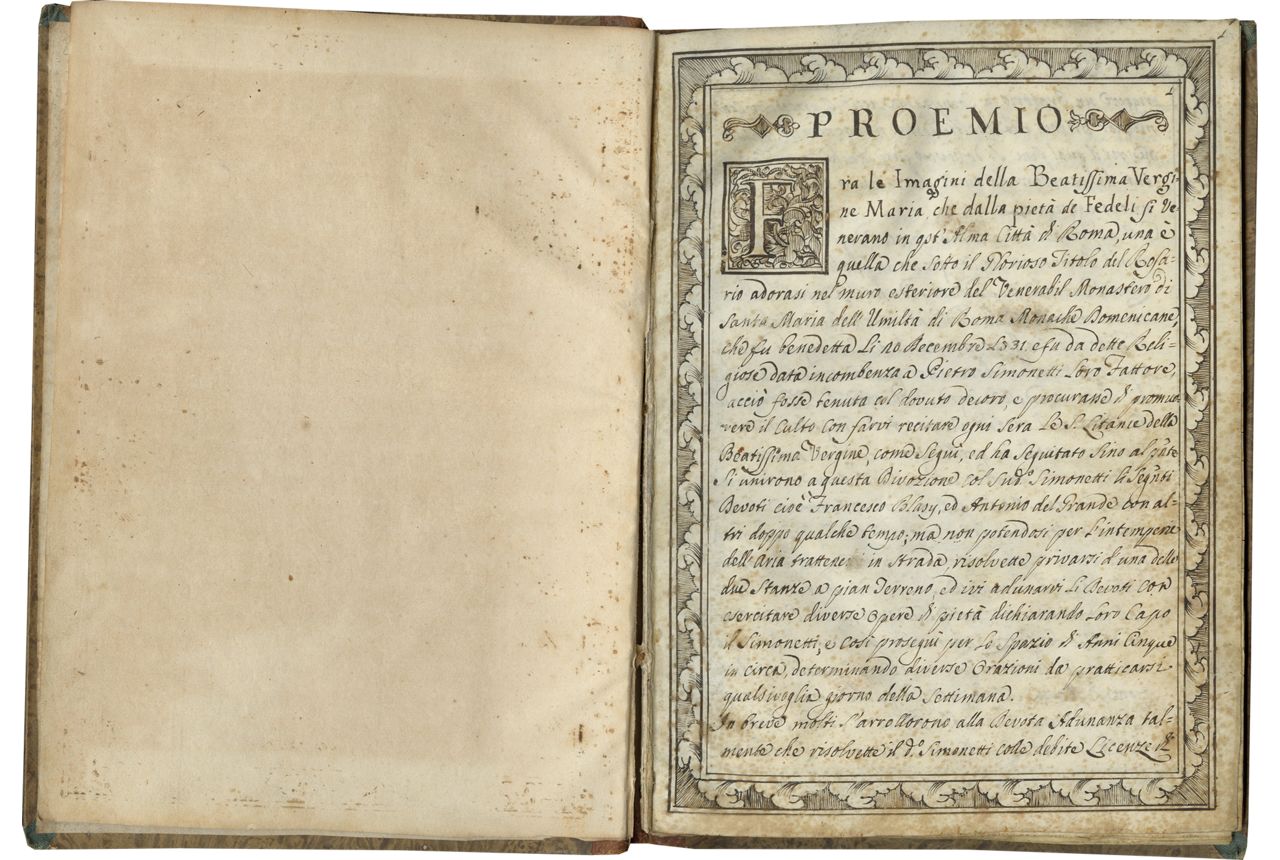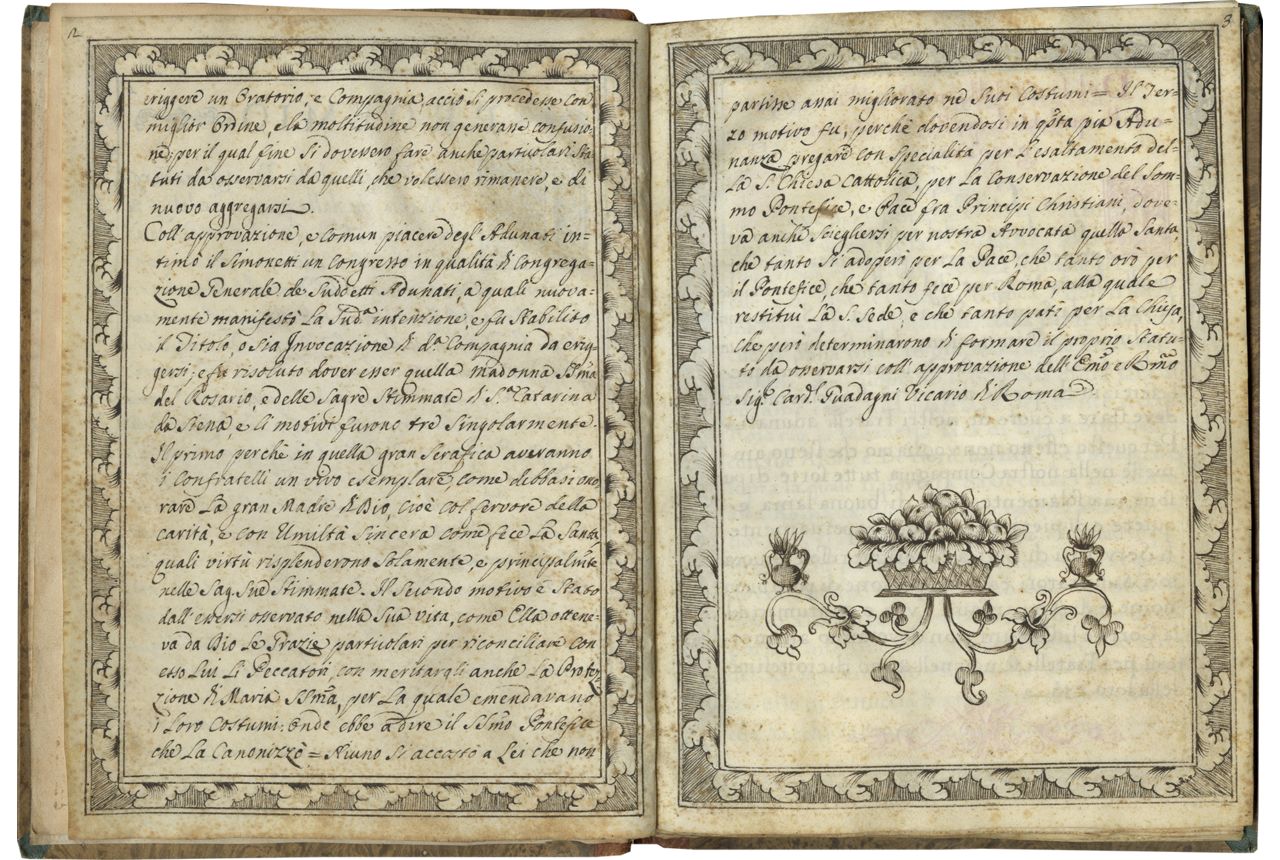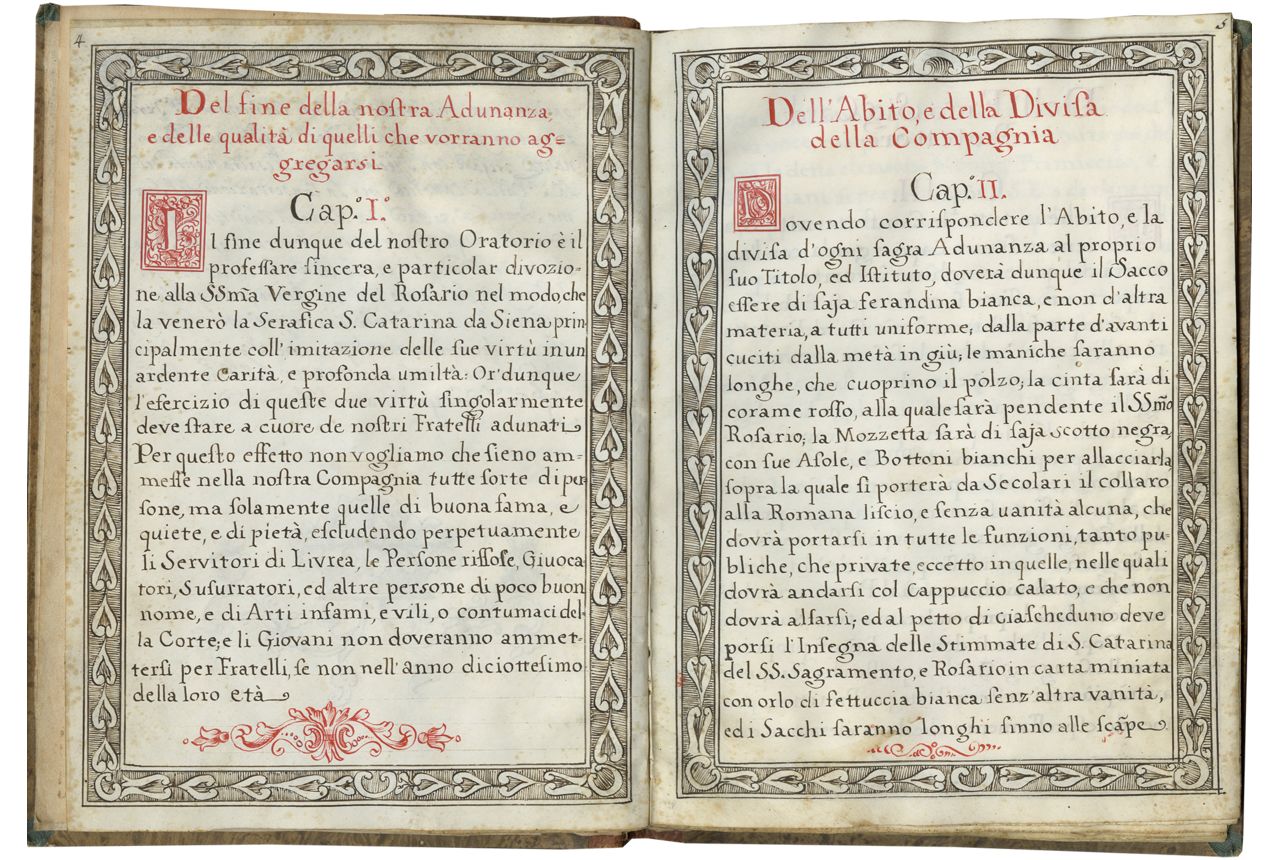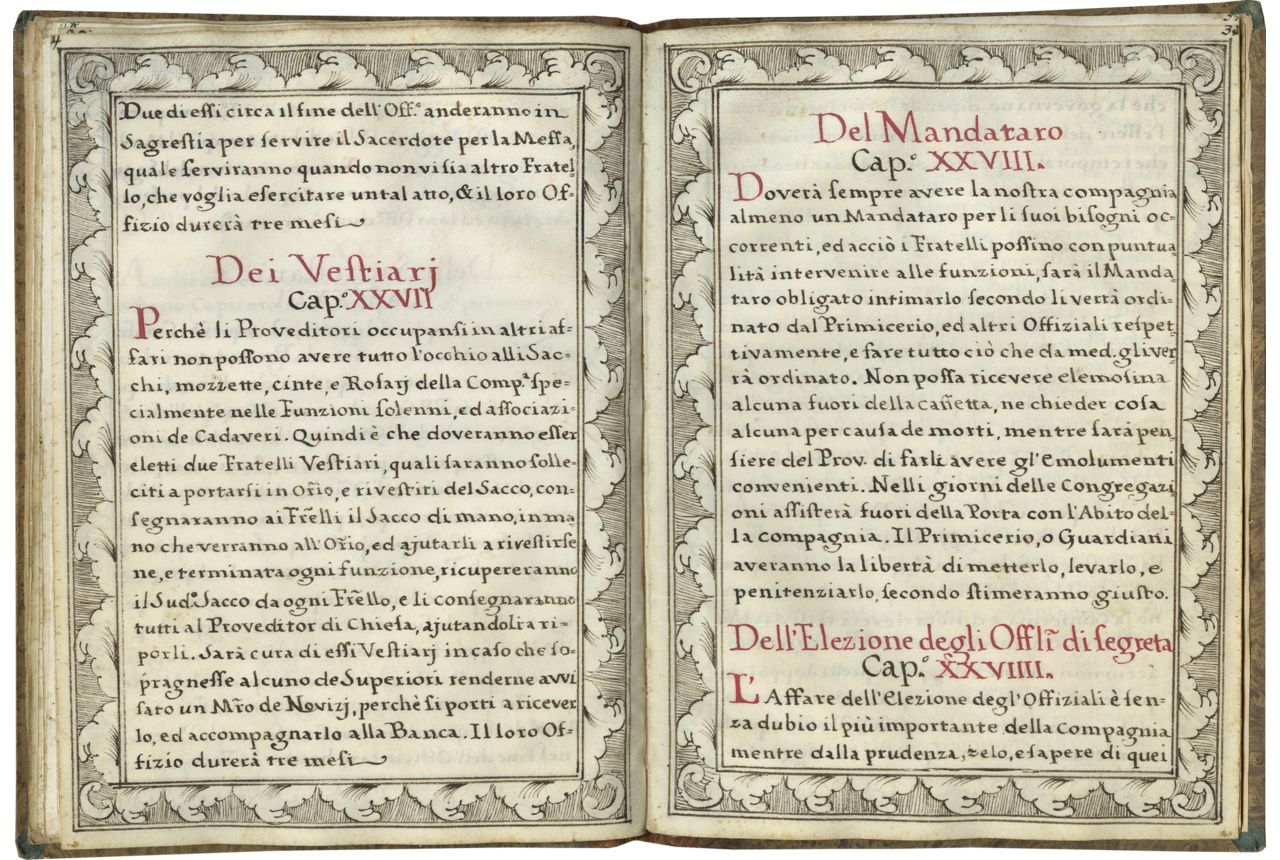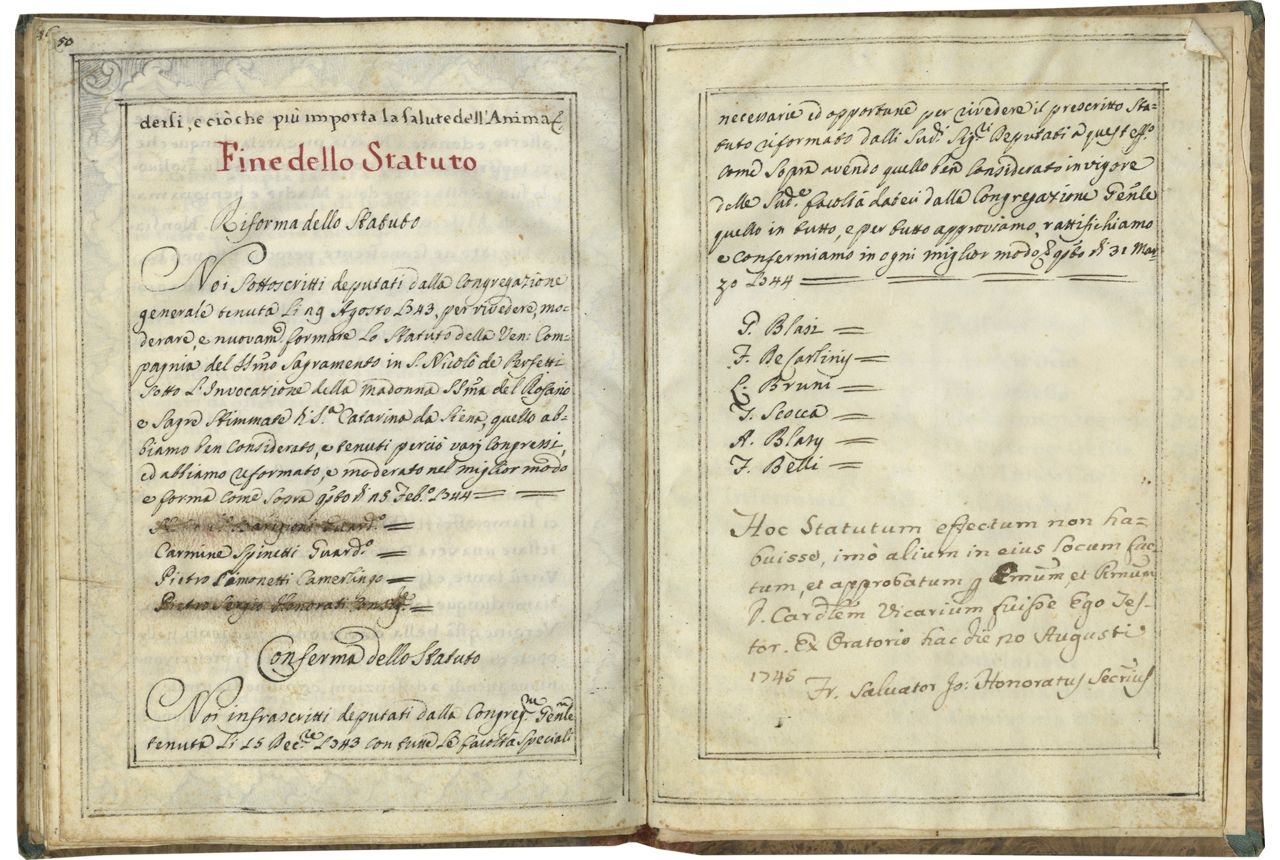i (paper) + 27 folios on parchment, pagination in black ink, top outer corners, 1-51 (final three pages unpaginated), complete (collation i7 [first leaf now single, original structure uncertain, but text is complete] ii-iii8 iv4), no catchwords or signatures, ruling usually indiscernible, but ruled very faintly in ink (justification 190 × 127 mm), written in black ink in italic and in an upright script modelled on Roman font in 25 long lines, red rubrics, full decorative borders drawn in black ink throughout, five 3-line and one 4-line initials drawn in red ink with acanthus, one 6-line initial drawn in black ink with acanthus, decorative tail pieces imitating printers marks with scrolls, vines, and amphoras drawn in red and black ink throughout, slight darkening to edges. ORIGINAL BINDING of eighteenth-century quarter leather binding with decorative paper covered boards, slight wear on corners, first quire loosened from bottom cord. Dimensions 231 × 167 mm.
To our knowledge, this is the only surviving manuscript of the unedited and unprinted statutes of the Confraternity of the Holy Sacrament of S. Nicolò dei Perfetti in Rome, bringing to life the social, cultural, and religious values of a lay confraternity. This carefully written and decorated manuscript illustrates the interesting continuation of manuscript culture (in this case clearly influenced by the aesthetics of contemporary printed volumes) in the eighteenth century.
Provenance
1. Written and decorated in Rome for the Confraternity of the Holy Sacrament) in S. Nicolò dei Perfetti (modern spelling, San Nicola dei Prefetti), Rome; the Statutes were originally ratified c. 1736; additions at the end of the manuscript confirming reforms to the statutes are dated 1744-1745.
2. Auction and other notes, all in pencil, in several hands, front flyleaf: “LB 147955/ 40 76327a”; price code, “BNNY”; “$500”; other notes, inside front cover, were erased (traces visible);
3. Kroch’s Bookstore, Inc., 206 N. Michigan Ave, Chicago. Typed description from Kroch’s bookstore laid in; Kroch’s was one of the largest sellers in Chicago in the first half of the nineteenth century. The manuscript was there between 1927 when Kroch moved his store to 206 N. Michigan Ave and 1933 when he merged his business with Brentano’s. The insert incorrectly dates the manuscript to 1531 and identifies it simply as the “Statues of the Order of Saint Catherine.”
Text
pp. 1-3, Proemio, incipit, “Fra le Imagini della Beatissima Vergine Maria che dalla pietà de Fedeli si venerano…coll approvazione dell Eminentissimo e Beatissimo signori Cardinali Guadagni Vicario di Roma”;
pp. 4-50, Del fine della nostra Adunanza e della qualità di quelli che vorranno aggregarsi (Cap.° I.), incipit, “Il fine dunque del nostro Oratorio è il professare sincera, e particolar divozione alla Santissima Vergine del Rosario nel modo, che la venerò la Serafica S. Catarina da Siena …; [p. 48], Conclusione dell’Opera, XL, incipit, “Non si può meglio conchiudere il presente Statuto … più importa la salute dell’Anima,” Fine dello statuto;
Statutes, divided into forty chapters.
pp. 50-51, Riforma della Statuto, incipit, “Noi sottoscritti deputati dalla Congregazione generale tenuta li ng[?] Agosto 1743, per rivedere moderare e nuova[mente] formare Lo Statuto della Ven. Compagnia del santissimo sagramento in S. Nicolò de Perfetti … “; [signed by four signatories, two crossed out, Carmine Spinetti, Guardino, and Pietro Simonetti Camerlingo, and dated February, 1744];
pp. 50-51, Conferma dello Statuto, incipit, “Noi infrascritti deputati dalla Congregazione generale tenuta li 15 Dec. 1743 …” [dated March 31, 1744 and signed by six signatories]; [followed by a formal confirmation added in another hand], incipit, “Hoc Statutum non habuisse imo alium in eius locum factum et approbatum … Ex Oratorio hac die 20 Augusti 1745, Fr. Saluator Jo. Honoratus Secretarius; [p. 52, blank apart from ruling for border];
p. 53, Rubricella, incipit, “Proemio … Conclusione, 40, Riforma della statato, 41, Conferma dello statuto.”
This manuscript contains the statues for the confraternity of the most Holy Sacrament of the Church of San Nicolò dei Perfetti in Rome (Compagnia di SS. Sagramento di San Niccolò dei Perfetti). The statues specify the basic regulations of the confraternity such as the election of its chief officers (the Guardiani and Camerlingo), maintenance of the company’s archives, care for the sick, funerary arrangements for deceased members, and so forth.
According to the prologue, the confraternity was formed in 1731 by a priest named Pietro Simonetti following the installation of an image of the Madonna of the Rosary on the exterior wall of the convent of Santa Maria dell’Umilità (founded in 1601 by noblewoman Francesca Baglione Orsini). Hoping to promote the cult of this new image, Simonetti gathered a group of followers, including two “pious gentlemen” identified as Francesco Balsey and Antonio del Grande, who met weekly before the image of the Madonna to recite the Litany of the Virgin. Inclement weather soon forced Fr. Simonetti to procure rooms indoors (presumably within the convent of Santa Maria dell’Umilità) where the company could formally meet, and after five years the confraternity held a congress in which it adopted official statutes, contained here, and procured licenses to build an oratory at the Church of San Niccolò dei Perfetti.
The confraternity officially adopted the Madonna of the Rosary, Saint Francis of Assisi, and Saint Catherine of Siena as patrons. The statutes were officially approved by Cardinal Giovanni Antonio Guadagni (1674-1759), presumably in 1736 or shortly thereafter. Entries in the rear of the book mention a second congress held seven years later in December of 1743 that initiated significant reforms to the confraternity’s statues. Ratifying signatures including Camerlengo Pietro Simonetti and Guardiani Carmine Spinetti verify the alterations; a final note was written in Latin by Cardinal Guadagni’s secretary “Fr. Salvatore JO.”
We have been unable to find further information about this confraternity in secondary sources (not recorded in Fiorani, 1985; Fiorani, 1984 was unavailable for consultation), apart from a mention of it in 1740 (Notizie, 1762, pp. 113-114), and a description of San Nicolò dei Perfetti which notes that there was an adjacent oratory (“newly built”) of the Holy Sacrament dedicated to St. Catharine of Siena (Venuti, 1766, pp. 348-349); these statutes, and in particular the informative prologue which tells the story of the origin of the confraternity, are therefore a particularly interesting primary source.
Confraternities were (and still are) associations centered around religious observances and charitable works. According to Miri Rubin’s expansive definition, medieval confraternities were formed “to promote welfare and security within a framework governed by an idiom of kinship, entered into and forged by ritual, and bound by mutual obligation” (Rubin, 1993, p. 186). The recent volume on confraternities edited by Eisenblicher (2019) demonstrates continued historical interest in confraternities: “After the State and the Church, the most well-organized membership system of medieval and early modern Europe was the confraternity. In cities, towns, and villages it would have been difficult for someone not to be a member of a confraternity, the recipient of its charity, or aware of its presence in the community.” Through almsgiving and practical services such as lodging, hospitality and nursing, confraternities physically supported the poor and needy of their communities and heightened the members’ aspirations for the afterlife. Confraternities created communities that extended beyond the family or the parish and often competed with other ecclesiastical institutions. Members prayed for each other, cared for the same shrines, and wore the same clothing when they marched in procession. Just as parishes created bonds between parishioners, these brotherhoods (cofradías) maintained the connections between the living and the dead, the rich and the poor.
Literature
Black, Christopher F. Italian Confraternities in the Sixteenth Century, Cambridge, 1989.
Eisenbichler, Konrad. ed. A Companion to Medieval and Early Modern Confraternities, Leiden and Boston, 2019.
Fiorani, Luigi, ed. Storiografia e archivi delle confraternite romane, Ricerche per la Storia Religiosa di Roma, 6, Rome, 1985.
Fiorani, Luigi, ed. Le confraternite romane. Esperienza religiosa, società, committenza artistica, Ricerche per la Storia Religiosa di Roma, Rome, 1984 (not available for consultation).
Le Bras, G. “Les confréries chrétiennes: problèmes et propositions,” Revue historique de droit français et étranger, Quatrième série, 19 (1940-1941), pp. 310-363.
Notizie per l’anno 1762. Dedicate all’ .. principe il Sig. Cardinale Ignazio Crivelli …., Rome, 1762.
Rubin, Miri. “Fraternities and Lay Piety in the Later Middle Ages,” Einungen und Bruderschaften in der spätmittelalterlichen Stadt, ed. Peter Johanek, Cologne, 1993, pp. 185-98.
Terpstra, N., ed. The Politics of Ritual Kinship: Confraternities and Social Order in Early Modern Italy, Cambridge, 2007.
Venuti, Ridolfino. Accurata e succinta descrizione topografica delle antichita di Roma …, Rome, 1766, vol. 1, pp. 348-349.
Available online, https://books.google.com/books?id=eoA5AAAAcAAJ&dq=san+niccolo+perfetti+roma&source=gbs_navlinks_s
Online Resources
Churches of Rome Wikki
https://romanchurches.fandom.com/wiki/San_Nicola_dei_Prefetti
(No mention of this confraternity, but the church does have an altar dedicated to Our Lady of the Rosary)
Churches of Rome Wikki, Santa Maria dell'Umiltà
https://romanchurches.fandom.com/wiki/Santa_Maria_dell%27Umilt%C3%A0
Fanning, William. “Confraternity (Sodality),” The Catholic Encyclopedia, vol. 4, New York, 1908
http://www.newadvent.org/cathen/04223a.htm
TM 1093


